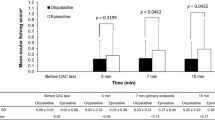Abstract.
Objective and Design: To develop a model of experimental allergic conjunctivitis, guinea pigs were given repetitive and topical applications of Japanese cedar pollen as an antigen, and the resulting allergic reaction was characterised.¶Subjects: Male Hartley guinea pigs.¶Treatment: Guinea pigs were sensitised by insertion of small gelatin sponge pieces (3 pieces/eye, both eyes) containing the pollen extracts + Al(OH)3 into the palpebra superior/inferior sulci of both eyes for 8 h/day for 6 days. Then the animals were challenged by dropping pollen suspension in each eye once every week.¶Methods: Time-course changes of conjunctivitis intensity score (CIS), which represents oedema and redness, and scratching frequency, and γ1 and IgE levels in sera were assessed following the respective 1st-17th challenges. Ophthalmic lavage was performed to assay for albumin leakage and migrated leukocytes at each of the odd-numbered challenges.¶Results: At relatively early stages of the repeated challenge, only a gradual increase of CIS was observed. However, thereafter, considerably higher CIS with the maximum at 30 min after the challenge was provoked at the 12th-17th challenges. Quite interestingly, there were differences in the CIS between the right and left eyes, depending on the individuals. Scratching, and albumin leakage and neutrophil influx into the lavage fluid were also developed during the challenges. Although the anaphylactic antibodies against the antigen were detected in the sera from half of the animals, the levels were not correlated to severity of the symptoms.¶Conclusions: The present sensitisation/challenge procedures are unique in terms of topical application of antigen. The lack of any correlation between the levels of the anaphylactic antibodies and severity of anaphylactic symptoms, and the difference of CIS between the left and right eyes of an individual strongly suggest that the anaphylactic antibodies are formed in locally limited tissue surrounding an eye. The present method should be useful for analysing the mechanisms of allergic conjunctivitis.
Similar content being viewed by others
Author information
Authors and Affiliations
Additional information
Received 15 November 1998; returned for revision 7 February 1999; accepted by M. Katori 14 March 1999
Rights and permissions
About this article
Cite this article
Yasuda, M., Kato, M., Nabe, T. et al. An experimental allergic conjunctivitis induced by topical and repetitive applications of Japanese cedar pollens in guinea pigs. Inflamm. res. 48, 325–336 (1999). https://doi.org/10.1007/s000110050468
Published:
Issue Date:
DOI: https://doi.org/10.1007/s000110050468




